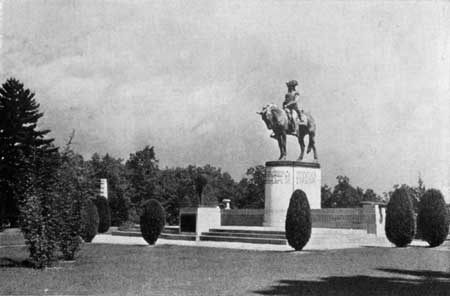MENU
|
Glimpses of Historical Areas East of the Mississippi River |
|
The Revolution |
|
NORTH CAROLINA |
Special Feature: Site of an important encounter between British and American forces on March 15, 1781.

Statue of Gen. Nathanael Greene, Guilford
Courthouse National Military Park.
(Photo by Rinehart)
GUILFORD COURTHOUSE NATIONAL MILITARY PARK was established in 1917 to commemorate the battle fought there on March 15, 1781, between an American force under Nathanael Greene and a British force under Cornwallis. Located 6 miles northwest of Greensboro, N. C., the park contains 119 acres of rolling forest and meadow land.
"The Battle of Guilford", wrote the historian John Fiske, "though tactically a defeat for the Americans, was strategically a victory and the most important one since the capture of Burgoyne." After the conflict at Cowpens, the British commander, eager to avenge his defeat, had pursued the small force under Nathanael Greene to a point near time Virginia border. Failing to catch his vigilant opponent, Cornwallis marched back to Hillsborough, N. C., raised the royal standard, and attempted to assemble the Tory militia. Greene's army, which numbered only about 1,430 when he retreated into Virginia, soon was increased to between 4,500 and 5,000, but fewer than 500 of his men had ever been under fire. Believing that he could now risk a fight, Greene drew up his troops in a defensive position at Guilford Courthouse. South Carolina and Georgia had been overrun by the British, and Greene felt that if a blow were not struck soon they might secure control of the entire South. Cornwallis had only about 2,200 men, but nearly all were veteran regulars who had fought in the North as well as the South. Relying on the superior quality of his troops, he did not hesitate to attack the American position.
The soldiers on both sides were drawn up much as they had been at Cowpens, with the Americans in three lines. The British advanced in a massed attack, relying largely on their bayonets. The American militia in the first line had no bayonets, and they were further handicapped by the fact that it took them 3 minutes to reload their muskets. After firing two volleys they retreated, though Henry Lee's cavalry remained in position.
The second line held more stubbornly, but in turn slowly retreated. The British were then temporarily repulsed by the third line composed of the regular Continental force. The tide seemed to be turning in favor of the Americans and the British began to fall back. Although they had fought gallantly, their retreat was checked only by Cornwallis in person. He ordered two field pieces to be fired into the fighting mass, some of his own men being wounded. Greene did not wish to risk a further vigorous attack with his sole remaining line and retreated to another defensive position 10 miles distant. He had lost 78 killed, 183 wounded, and 1,046 militia missing. Cornwallis' casualties were 93 killed, 413 wounded, and 26 missing—nearly 30 percent of his strength. Greene had lost the battle but won the campaign. Having failed to destroy the American force, and being far from his base, Cornwallis' position was precarious. He felt a retreat was imperative and accordingly marched to Wilmington, and thence into Virginia, where his army was captured at Yorktown.
Memorials have been erected at various points on the battlefield, the most important of which is that to General Greene, erected by the Government at a cost of $25,000. Another monument is dedicated to William Hooper and John Penn, two North Carolina signers of the Declaration of Independence whose remains were reinterred at Guilford in 1894. Maps of the battle, rifles, cannon balls, and other materials pertaining to the battle are on display at the park museum.
NEXT> Colonial National Historical Park
 Top
Top
Last Modified: Thurs, Nov 23 2000 10:00:00 pm PDT
http://www.cr.nps.gov/history/online_books/glimpses3/glimpses2f.htm
![]()
